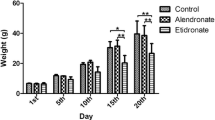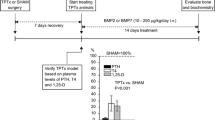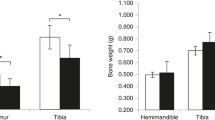Abstract.
To determine the effects of a bisphosphonate on the quality of bone morphogenetic protein-(BMP-) induced bone, incadronate was administered to rats in which subcutaneous ectopic bones were induced by recombinant human BMP-2. Incadronate (1 μg/kg/day) was administered to rats carrying the BMP-induced bones three times per week, from the 3rd to 7th week after BMP implantation (incadronate group). Aliquots of phosphate-buffered saline were administered in the same protocol without incadronate to the control group. During the 3rd, 4th, 7th, or 10th week, the BMP-induced bones were removed and observed by contact microradiography (CMR), H&E staining, enzyme histochemistry for tartrate-resistant acid phosphatase (TRAP), and immunohistochemistry for cathepsin K. By 3 weeks when administration of incadronate began, woven bones formed in the periphery of the BMP pellets and osteoclasts were attached to these bones. At 4 weeks, in both the incadronate and control groups, bone formation advanced inward. However, in the incadronate group, poorly calcified areas, corresponding to the remaining BMP pellets, were found in the middle areas of bone formation, whereas osteoclasts decreased when compared with those of the control group. During the 10 weeks, bone marrow was formed and the characteristics of lamellar bones, in which the lacunae of small osteocytes were regularly arranged, were noted in the control group. In contrast, the poorly calcified areas were still present up to 10 weeks in incadronate group in which the osteoclasts were also scarcer than in the control group. These findings suggested that osteoclast-mediated bone resorption was inhibited by incadronate administration, and that immature bones including the BMP pellets remained for a long time, indicating that the process of bone maturation was blocked. The possibility of using incadronate for the purpose of inhibiting osteoclastic bone resorption was confirmed, but further study is needed before clinical application.
Similar content being viewed by others
Author information
Authors and Affiliations
Additional information
Received: November 27, 2001 / Accepted: June 13, 2002
Acknowledgments. We thank Dr. K. Takahashi (Yamanouchi Pharmaceutical Co.) for providing rhBMP-2 and incadronate, and we also thank the staff of the First Department of Oral Anatomy for their advice and the staff of the First Department of Oral and Maxillofacial Surgery for their useful discussion and technical assistance. This work was supported in part by a grant from Research Fellowships of the Japan Society for the Promotion of Science for Young Scientists (No. 8435) to K. Hoshi and a Grant-in-Aid for Scientific Research from the Ministry of Education, Science, Sports and Culture of Japan (No. 10877289, 11307038) to H. Ozawa.
Offprint requests to: K. Hoshi
About this article
Cite this article
Gong, L., Hoshi, K., Ejiri, S. et al. Bisphosphonate incadronate inhibits maturation of ectopic bone induced by recombinant human bone morphogenetic protein 2. J Bone Miner Metab 21, 5–11 (2003). https://doi.org/10.1007/s007740300001
Issue Date:
DOI: https://doi.org/10.1007/s007740300001




